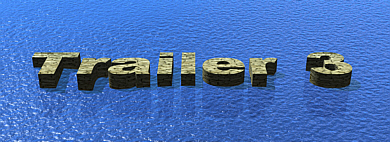|
Here we are at the supreme discipline in film editing. Where artists used to paint with paint brushes on panes of glass (hence the term "matte painting"), today's effects are mainly created with 3D programs. Nowadays there is hardly a blockbuster that has not used a 3D program and the quality is now so good that you hardly notice the difference or often can no longer tell the difference, is it really real or virtual in a computer Program emerged.
Or to put it another way: who saw the trees falling from the truck in "Final Destination 2" thought real? At first I was convinced they were real. Until I saw the making-of on the internet and had to realize that they are from the computer...
Since I've dabbled in 3D programs myself, I know why the list of people watching movies like "Shrek" or "Finding Nemo" is so incredibly long. There are several areas in 3D programs and if someone could do all areas perfectly, I think they would be a genius. With such animated films, there are people who do nothing but modelling, i.e. creating the virtual characters. Still others are only responsible for the background. Still others only do the lighting, i.e. placing objects that simulate light sources. Others only do the surfaces and still others only the movements of the characters. And like I said, since I've been dealing with it myself, I know how complicated it is. Hence my name "king discipline". Imagine you have an empty space in front of you and you have to fill it first. So loosely based on the principle "let there be light" you place an object in a virtual, three-dimensional space that generates light. So, now you see something. No? you see nothing? It is also clear that there is nothing in your virtual universe yet. So we create a surface that we color a dark blue. So that the background doesn't look black, we'll give it a light blue color. Reminds me of a blue sky with a sea. The basic objects are set. So that the whole thing looks a little more real and natural, we now have to consider: What does water actually look like? How is light reflected from it? What movements does it make? And then it gets really complicated. One must define the size of the highlights that a light source reflects back from the water surface. Must generate a surface pattern, known in technical jargon as a "shader" designated. Define undulations, transparency, change in appearance when viewed from different angles, etc.
In other words: the more things you define and the closer these things are to the original (the properties of the sea in nature), the more real our water will appear later. This can be so real that the difference can no longer be seen on a still image (see pic above - click on it to enlarge). But as I said, everything is very, very complicated and what apparently took God six days, I worked on it for several months and my compi calculated about 36 hours on it. Mind you: 36 hours of 29 seconds of film, because each individual image has to be calculated in virtual, three-dimensional space with all its properties such as light, shadow, surface, etc. |




